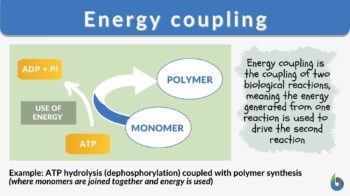
Energy coupling
n., [ˈɛnədʒɪ ˈkʌplɪŋ]
Definition: coupling of two biological reactions
Table of Contents
What is Energy Coupling?
Work, whether it be physical or biological, requires energy to be expended. In biological organisms, ATP is the source of energy for all cellular work. When we discuss the role of ATP molecules, energy coupling reactions become significant. Now, the question pops up, what is energy coupling and how do we define energy coupling!
Energy coupling, by definition, stands for a concept of coupling two biological reactions; meaning energy generated from one reaction is used to drive the second reaction. Two different reactions or biological systems are coupled together or put into synchrony this way. All cells have majorly 2 types of reactions going on in them: (1) exergonic reactions that are energy-releasing reactions (thus, energetically-favorable) and (2) endergonic reactions that are the energy-demanding reactions (thus, energetically-unfavorable). Many times, the cell couples these two reactions and bridges the gap between them. The energy that is released by the exergonic reactions is channeled down to the endergonic reactions to make them energetically favorable too.
This smart work by the cell ensures that the cellular reactions never run out of the energy source i.e., ATP. This “reactions linking or coupling” is a vital mechanism that ensures that the cellular machinery never grinds down to a halt and the cell remains alive! It is through this energy coupling that cells use ATP in the endergonic reactions…
What is the Role of the ATP In This Process?
ATP stands for adenosine triphosphate. It is a small molecule that’s commonly called the energy currency of the cell. The basic structure of ATP has 3 main components. They are adenine (the nitrogenous base), ribose (the sugar) and three phosphate groups bonded one after another (labeled as alpha, beta, gamma from point of attachment to end).

Coupling occurs when the energy released by an exergonic reaction is linked to an endergonic reaction. The three phosphates of ATP are energetically bound to the main structure (nucleoside- adenosine). Although not all phosphate groups are linked by a high-energy bond, the amount of energy released during the ATP hydrolysis process is amazing. Numerous cellular reactions from metabolic transformations to cell responses to cell signaling events are powered by ATP hydrolysis.
ATP hydrolysis reaction
ATP + H2O 🡪 ADP + Pi (ADP in biology means Adenosine Diphosphate)
ADP + H2O 🡪 AMP + Pi (AMP in biology meeans Adenosine Monophosphate)
This reaction of ATP hydrolysis (meaning the conversion of adenosine triphosphate to adenosine diphosphate) results from the breakage of the two phosphoanhydride bonds. The amount of energy associated with these hydrolysis reactions varies from cell to cell and depends on micro-environmental conditions, organisms, ionic strengths (especially Mg2+ concentration), physiological conditions, concentrations of ATP, ADP, Pi, etc. Typically, it lies between -28.0 to -33.5 kJ/mol. (Rosing, 1972).
- Under standard conditions, the Gibbs free energy associated with ATP hydrolysis has been found to be in the range of -35.0 to -40.0 kJ/mol.
- But under physiological conditions (in a living cell), the Gibbs free energy associated with ATP hydrolysis has been found to be in the range of -50.0 to -72.0 kJ/mol.
Have a look at the picture below to understand the variations and range of energy release in different organisms.
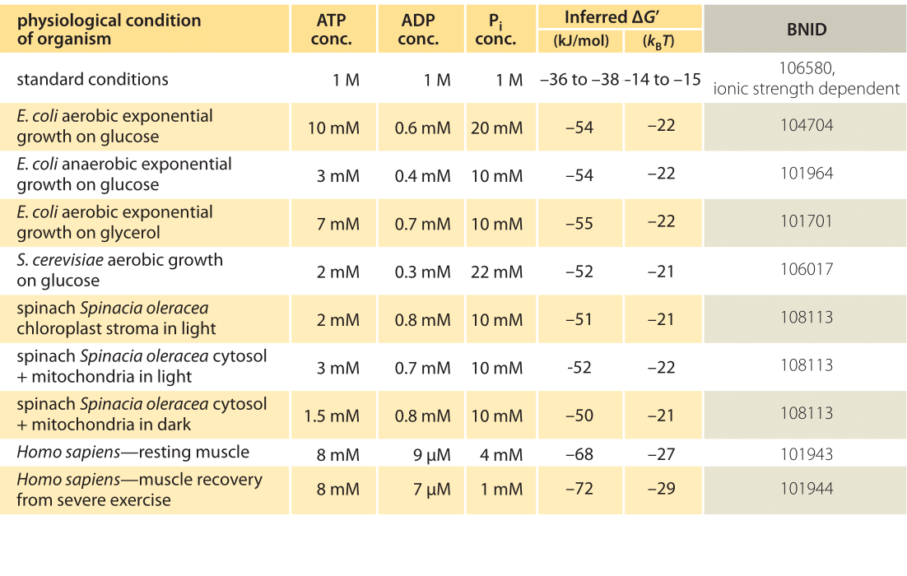
How Does ATP Play a Role In Energy Coupling?
Now, let’s answer some basic questions.
Question 1: What’s the role of ATP in energy coupling?
Answer: ATP is the molecule whose burst of energy is used to couple an exergonic reaction to power an endergonic reaction in energy coupling. ATP coupling provides that endergonic reaction with the potential to manifest now. Without an input of energy, the Gibbs free energy of the reactants in an endergonic reaction is “too low”. Only when supplemented with energy from ATP hydrolysis, that the endergonic reaction can happen. Hence, the indispensable role an ATP molecule plays in energy coupling is beyond comparison and invincible.
Question 2: Does hydrolysis release energy?
Answer: Yes, because hydrolysis reactions involve a water molecule addition to a large molecule/polymer and its disintegration into smaller molecules/monomers. This is accompanied by the release of energy.
Question 3: Is ATP hydrolysis reversible?
Answer: Yes, ATP to ADP conversion is reversible. It happens via phosphorylation and dephosphorylation. Here, ATP once converted to ADP by hydrolysis can be re-converted to ATP by “chemiosmotic coupling/phosphorylation” in the inner membranes (IM) of mitochondria:
Phosphorylation: Adenosine-Pi-Pi + Pi + Free Energy 🡪 Adenosine-Pi-Pi-Pi
Dephosphorylation: Adenosine-Pi-Pi-Pi 🡪 Adenosine-Pi-Pi + Pi + Free Energy
To learn more about chemiosmotic coupling/phosphorylation and ATP generation, read our article on “MITOCHONDRIA”
Question 4: Is ATP hydrolysis exergonic?
Answer: Yes, because the Gibbs free energy of the products is lesser than the Gibbs free energy of the reactants.
Question 5: Is anabolism endergonic?
Answer: Yes, all anabolic reactions are endergonic meaning they need the input of energy. Contrastingly, catabolic reactions (or catabolism) are exergonic; meaning they release energy.
How Energy Coupling Works
Before we begin explaining the working of energy coupling to you, you must first understand the meaning of coupled reactions. “Coupled reactions” result from a well-balanced combination of two different types of reactions:
Table 1: Spontaneous reaction and Non-Spontaneous reaction |
||
|---|---|---|
| Character | Spontaneous Reaction | Non-Spontaneous Reaction |
| Energy-wise | Exergonic | Endergonic |
| ΔG | ΔG>0 | ΔG<0 |
| Thermodynamically | Favorable | Unfavorable |
| Functioning | Drives the thermodynamically unfavorable reaction | Require energy application externally |
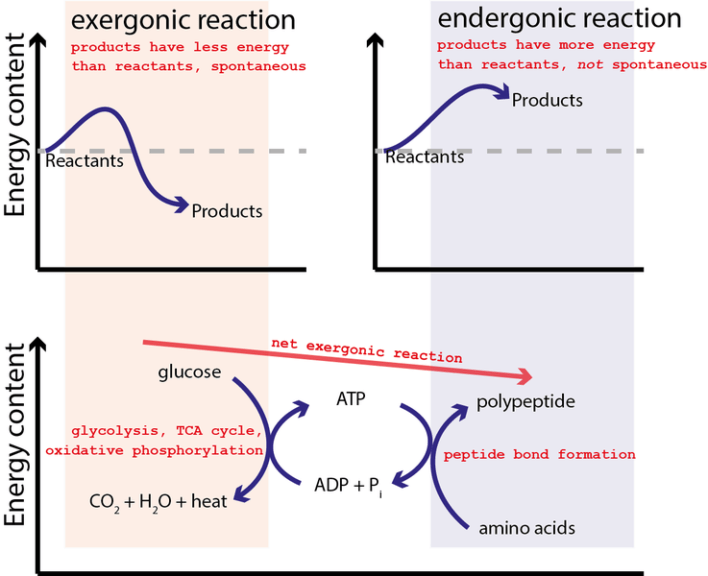
Energy coupling in glycolysis
Now to understand how energy coupling works, let’s take an example of coupled reactions in glycolysis. For different types of cellular reactions and pathways, biochemical molecules need modification to become “suitable conformed substrates” for some particular step they’re involved in. Glucose is one such example. For the glycolysis pathway in cellular respiration, glucose needs to have a phosphate group attached to it. You must be wondering who is kind enough in a living cell to donate that phosphate group to glucose???
Yes, you’re right. It’s an ATP!
Inside a cell, ATP hydrolysis is coupled to this conversion of glucose to glucose-6-phosphate. This phosphorylation step makes the glucose conformationally suitable for the further step of conversion to fructose. And like this glycolysis proceeds further and cellular respiration goes on, unabated…
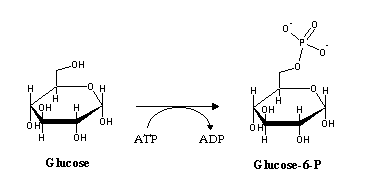
Now that you’re clear about energy coupling, let’s understand how it plays a role in some other systems of the living cell.
Energy coupling in sodium-potassium pumps
The Sodium-Potassium pump is an important transmembrane ion pump inside all cells. This Na+/K+ pump pushes three Na+ from the cytoplasm to the extracellular fluid and two K+ from the extracellular fluid to inside the cytoplasm. The functioning of this pump is vital to maintain the membrane polarity and resting potential. It also serves several other purposes inside a cell-like signal transducer, neuron activity state controller, cell volume controller, transportation, etc.
Since both Na+ and K+ need to be pumped in directions against their concentration gradients, this calls for an “energy demand”. Here comes the role of ATP hydrolysis. For every three Na+ that are pumped out of the cell and for every two K+ that are pumped into the cell, one ATP molecule is hydrolyzed. This hydrolysis ensures that the conformation of the sodium-potassium pump changes in accordance with the transfer of the respective molecules in and out of the cell.
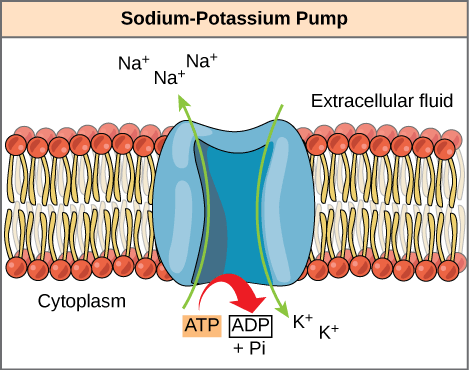
Energy Coupling and Metabolism
The energy coupling mechanism plays an important role in balancing the 2 types of metabolisms going on inside the cells; anabolism and catabolism. Anabolic reactions require energy (endergonic in nature) to happen. To sustain anabolic reactions in a biological system, some source of energy has to be coupled with them. Hence, catabolic reactions are often coupled with them since they are exergonic in nature (release energy).
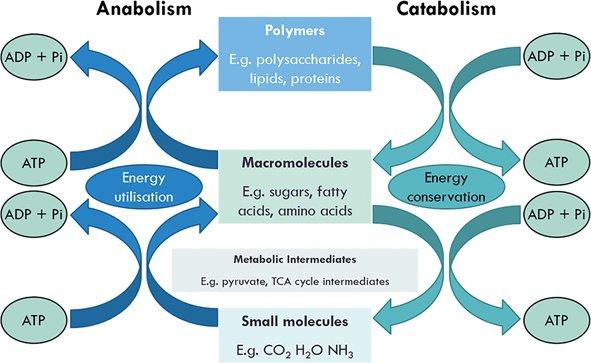
Importance of Energy Coupling
Energy coupling of endergonic and exergonic reactions within cells ensures that whatever amount of energy is produced in the first exergonic reaction does not dissipate as heat. Also, energy coupling ensures that it’s properly directed within a biological system to a secondary reaction- the endergonic one, where it can be used rather than getting wasted!
In short, energy coupling ensures that the energy from REACTION-1 serves as a “FUEL” for REACTION-2.
Energy coupling examples
Through energy coupling, cells use ATP for various different purposes like:
- ATP hydrolysis coupled with Glucose to Glucose-6-Phosphate conversion
- ATP hydrolysis coupled with Sodium-Potassium Pumps
- ATP hydrolysis coupled with Starch/Glycogen/Cellulose formation (formation of chains of sugars)
- ATP hydrolysis coupled with the formation of RNA
- ATP hydrolysis coupled with the synthesis of biomolecular polymers- carbohydrates, lipids, proteins, and nucleic acids
- ATP hydrolysis is coupled with important biological pathways like glycolysis, Krebs cycle, gluconeogenesis, etc.
Try to answer the quiz below to check what you have learned so far about energy coupling.
References
- Rosing, J., Slater, E.C. (1972) The value of G^o of the hydrolysis of ATP.. Biochim Biophys Acta. 267(2):275-90. Table VIII p. 287
- Standard Gibbs free energy of ATP hydrolysis – Generic – BNID 101989. bionumbers.hms.harvard.edu.
- Zubay, Geoffrey. (1988) Biochemistry. New York: Macmillan Publishing Company
- Judge, A., & Dodd, M. S. (2020). Metabolism. Essays in biochemistry, 64(4), 607–647. https://doi.org/10.1042/EBC20190041
- Kalckar H. M. (1941) The Nature of Energetic Coupling in Biological Syntheses. Chemical Reviews, 28 (1), 71-178. DOI: 10.1021/cr60089a002
- Green, D. E., & Blondin, G. A. (1978). Molecular Mechanism of Mitochondrial Energy Coupling. BioScience, 28(1), 18–24. https://doi.org/10.2307/1307482
- Knight, A., Molloy, J. (1999). Coupling ATP hydrolysis to mechanical work. Nat Cell Biol 1, E87–E89 https://doi.org/10.1038/12083
- Bazhin N. (2012). The essence of ATP coupling. ISRN biochemistry, 2012, 827604. https://doi.org/10.5402/2012/827604
©BiologyOnline.com. Content provided and moderated by Biology Online Editors.



